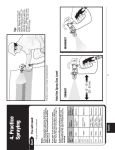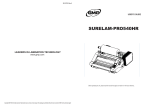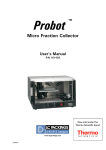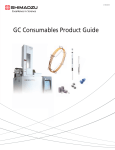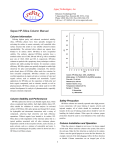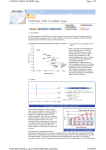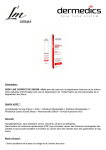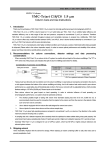Download Troubleshooting the Agilent 1100 HPLC
Transcript
Troubleshooting the Agilent 1100 HPLC In This Section, You Will Learn: • General troubleshooting strategy • Common Problems: – Pressure – Reproducibility • Retention time (Rt) • Area – – – – Linearity Baseline noise Sensitivity Peak shape 2 1 Important HPLC Parameters During the course of your work, monitor the following parameters: •Pressure •Baseline Noise •Retention time precision These parameters can tell you if your HPLC is experiencing problems. •Area precision •Peak height precision •Peak shape •Sensitivity 3 Why Do You Care if Your System Is Functioning Properly? Quantitative Analysis •Changes in flow rate caused by pumping problems result in incorrect area counts. •Noisy baselines will interfere with integration and decrease signal-to-noise ratio. •Poor autosampler maintenance will result in poor injection volume reproducibility. Qualitative Analysis •Retention time fluctuations resulting in incorrect identifications. •Spectral analysis difficulties. 4 2 Troubleshooting Key Concept Divide and Conquer Question Is the problem with the application method or the instrument? Action Test Mix 01080-68704 Inject a standard test mix of known behavior under known conditions ...............…HPLC Test Sample – Keep it simple: Test sample: 2- 3 Analytes (chemically stable) in sufficient concentration Test column: Record length, internal diameter, stationary phase, particle diameter Separation method: Solvent , flow rate, temperature, pressure, detection parameters Results: tR, peak width, resolution, peak area, peak height, baseline noise, signal/noise ratio of analytes 5 Problems with the System Pressure Pressure problems Pressure too high Pressure too low Pressure Unstable 6 3 Pressure Problem I Pressure Measurement Pressure Too High • Column inlet frit contaminated •Frit in purge valve contaminated • Column contaminated • Blockage in a capillary, particularly needle seat capillary Use this valve to divide the system • Rotor in injection valve plugged • Injection needle or needle seat plugged 7 Pressure Measurement Pressure Problem II Pressure Too Low z Solvent inlet frit plugged Leak in a capillary connection or other part (pump seals) z z z z z z Wrong solvent or flow rate Solvent inlet frits AIV (Active inlet valve) defective Multichannel Gradient valve incorrectly proportioning Ball valve defective Column defective (stationaryphase) 8 4 Pressure Problem III Pressure Fluctuation • Solvent inlet frits plugged • Solvent not degassed • Seals of the pump defective • Ball valve defective Solvent inlet frits • AIV defective Usually an indication there is air in the pump 9 Reproducibility Typically, Peak retention time precision: ⇒ with oven: < 0.3% ⇒ without oven: < 0.7% Peak area precision: <1.5% •Area and Peak Height problems together point to the autosampler system •Area and Retention Time problems together point to the pump 10 5 Problems with Reproducibility – Peak Areas Seal Peak Areas not Reproducible With peak height •Rotor seal cross-port leak or injection valve not tight •Piston seal of metering unit leaking •Needle partially blocked With retention time •Variable pump flow rate Other •Capillary from injector to detector not tight •Detector equilibration problems Pump Column Rotor 11 Problems with Reproducibiliy – Retention Time Retention Times not Reproducible • Pump Problems –Mobile phase composition problems –Valves AIV, ball valve defective –Flow rate problems •Column Oven Problems –Temperature fluctuations •Other –Column equilibration –Column deterioration 12 6 Linearity Problems Peak Areas not Linear Seal Autosampler •Rotor seal cross-port leak or injection valve not tight •Piston seal of metering unit defective •Needle partially blocked Detector •Satuaration 13 Baseline Fluctuations Possible Causes: Dirty Flow Cell Dirty mobile phase Detector Lamp Failing Pulses from Pump ( if Periodic) Temperature Effects on Detector (RI) Air Bubbles passing through Detector Gradient elution Immiscible Solvents 14 7 Troubleshooting Baseline Noise Stop Flow yes no Noise Still Exists? Pump or Mobile Phase? Detector? Other Questions to Ask ÎHave you changed your mobile phase composition? ÎHave you changed your acquisition wavelength? ÎWhat mobile phase was last used in your instrument? ÎDo you have a miscibility problem? ÎAre your solvents dirty? 15 Example - Ghost Peaks 60 Ghost Peaks - Peaks which appear even on blank injections Problem - Dirty Mobile Phase 15 30 15 0 3 7 20% - 100% MeOH Gradient No Sample Injected 15 17 16 8 Sensitivity Problems Peak response too low Causes: • insufficient injection amount • Detector problems • Lamp aging • Detector cell contamiated • Solvent absorption high 17 Peak Problems – Split/Tailing/Fronting Appendix 18 9 Peak Shape - Doublets Void Volume in Column Normal Doublet Peaks Void Volume in Column Partially Blocked Frit Only One-Peak a Doublet- Coeluting Components 19 Effect of Extra-Column Volume T im e , m in . 0 1 2 3 4 5 6 7 8 9 10 11 20 無 (1µL Injection) 10 無 F = 0 .2 m L / m in . 2 .1 x 1 5 0 m m V o lu m e E x t r a - C o lu m n Use short, small internal diameter tubing between the injector and the column and between the column and the detector. Make certain all tubing connections are made with matched fittings. Use a low-volume detector cell. Inject small sample volumes. 20 10 Peak Shape - Tailing Symmetry > 1.2 Causes Some Peaks Tail Secondary - Retention Effects Residual Silanol Interactions Small Peak Eluting on Tail of Larger Peak Î Normal Tailing All Peaks Tail Extra-Column Effects Build up of Contamination on Column Inlet Heavy Metals Bad Column Normal Tailing 21 Peak Shape - Fronting Peaks mAU 2000 1500 1000 500 0 0 5 10 15 20 25 Time (min) Normal Fronting Symmetry < 0.9 Causes: ÎColumn Overload ÎSmall Band Eluting Before Large Band 22 11 Review of Important Tests Leak test Temperature stability & accuracy Baseline noise/drift Precision of peak areas & RT Wavelength accuracy Detector linearity Autosampler carry over Autosampler linearity Composition accuracy/precision Composition ripple 23 Summary - Troubleshooting Exclude application errors Take a methodical and systematic approach Localize error in a part of the system Change only one thing at a time Ask for help where appropriate Plan course of action Verify if problem has been eliminated (test injection) Periodic maintenance of the Agilent 1100 prevents downtime 24 12












